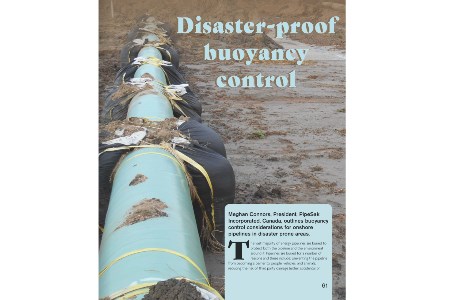Disaster-proof buoyancy control
Published by Emilie Grant,
Assistant Editor
World Pipelines,
The vast majority of energy pipelines are buried to protect both the pipeline and the environment around it.

Pipelines are buried for a number of reasons and these include: preventing the pipeline from becoming a barrier to people, vehicles, and animals; reducing the risk of third party damage (either accidental or intentional); protecting the pipeline from the elements; and improving protection of the environment in the case of a catastrophic pipeline failure.
While buried pipelines have always required a certain level of additional weight to counteract the buoyant force exerted on them from groundwater, they are not typically considered susceptible to damage from natural hazards. However, floods, seismic activity, landslides, and other types of soil movement can and do jeopardise pipeline integrity. When designing a buoyancy control system in these areas, soil and pipe movement potential must be a consideration.
Buoyancy control practices
Buoyancy control of buried pipelines is standard practice in areas where pipeline sections may be subject to buoyant forces during different stages of construction and operation. Virtually all onshore transmission pipelines cross buoyant environments at some point along their route. According to Archimedes’ principal, the upward buoyant force is equal to the weight of the water displaced, making large diameter pipelines particularly susceptible to floatation. Historically, the most direct solution to counteract buoyant forces was to increase the wall thickness of the steel pipe, making the pipe heavier than the water it displaces. However, this is generally not practical and the industry evolved to using external buoyancy control systems, including concrete set on weights, concrete coated pipe, helical screw anchors, and geotextile pipeline weights. While all these methods can achieve sufficient negative buoyancy, extra care must still be taken in areas subject to soil movement, either by natural disaster, flooding, or simple erosion.
To access the full version of this article and get a free trial subscription to World Pipelines, sign up here!
Read the article online at: https://www.worldpipelines.com/equipment-and-safety/24092025/disaster-proof-buoyancy-control/
You might also like
The World Pipelines Podcast - GERG and the future of Europe's gas pipelines
A conversation about the role of GERG in European gas pipeline innovation, research, and decarbonisation strategy. Featuring Alexandra Kostereva, Operations Manager at GERG (European Gas Research Group).
Tune in to the World Pipelines Podcast on your favourite podcast app today.

